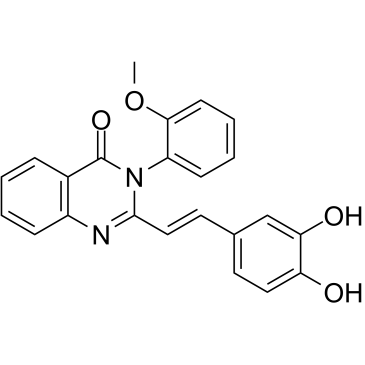Physicochemical Properties
| Molecular Formula | C₂₃H₁₈N₂O₄ |
| Molecular Weight | 386.40 |
| Exact Mass | 386.126 |
| CAS # | 2041072-41-5 |
| Related CAS # | 2041072-41-5 |
| PubChem CID | 135500267 |
| Appearance | Solid |
| Density | 1.3±0.1 g/cm3 |
| Boiling Point | 624.1±65.0 °C at 760 mmHg |
| Flash Point | 331.2±34.3 °C |
| Vapour Pressure | 0.0±1.9 mmHg at 25°C |
| Index of Refraction | 1.644 |
| LogP | 3.89 |
| Hydrogen Bond Donor Count | 2 |
| Hydrogen Bond Acceptor Count | 5 |
| Rotatable Bond Count | 4 |
| Heavy Atom Count | 29 |
| Complexity | 649 |
| Defined Atom Stereocenter Count | 0 |
| SMILES | O(C)C1C=CC=CC=1N1C(C2C=CC=CC=2N=C1/C=C/C1C=CC(=C(C=1)O)O)=O |
| InChi Key | OTKDKQJFWIGZLU-ACCUITESSA-N |
| InChi Code | InChI=1S/C23H18N2O4/c1-29-21-9-5-4-8-18(21)25-22(13-11-15-10-12-19(26)20(27)14-15)24-17-7-3-2-6-16(17)23(25)28/h2-14,26-27H,1H3/b13-11+ |
| Chemical Name | 2-[(E)-2-(3,4-dihydroxyphenyl)ethenyl]-3-(2-methoxyphenyl)quinazolin-4-one |
| Synonyms | ICCB-280; ICCB280; ICCB 280 |
| HS Tariff Code | 2934.99.9001 |
| Storage |
Powder-20°C 3 years 4°C 2 years In solvent -80°C 6 months -20°C 1 month |
| Shipping Condition | Room temperature (This product is stable at ambient temperature for a few days during ordinary shipping and time spent in Customs) |
Biological Activity
| Targets | C/EBPα |
| ln Vitro |
ICCB280 (0.1-50 μM; 48 h) suppresses the HL-60 cell growth, with an IC50 of 8.6 μM[1]. ICCB280 (10 μM; 2-8 d)) elevates C/EBP expression (mRNA and protein) and modifies its target genes in HL-60 cells[1]. ICCB280 (10 μM; 7 d) causes granulocytic differentiation and subsequently apoptosis in HL-60 cells[1]. |
| References |
[1]. A Cell-Based High-Throughput Screening for Inducers of Myeloid Differentiation. J Biomol Screen. 2015 Oct;20(9):1150-9. [2]. Styryl Quinazolinones as Potential Inducers of Myeloid Differentiation via Upregulation of C/EBPα. Molecules. 2018 Aug 3;23(8):1938. |
Solubility Data
| Solubility (In Vitro) | DMSO: ~83.3 mg/mL (~215.7 mM) |
| Solubility (In Vivo) |
Solubility in Formulation 1: ≥ 2.08 mg/mL (5.38 mM) (saturation unknown) in 10% DMSO + 40% PEG300 + 5% Tween80 + 45% Saline (add these co-solvents sequentially from left to right, and one by one), clear solution. For example, if 1 mL of working solution is to be prepared, you can add 100 μL of 20.8 mg/mL clear DMSO stock solution to 400 μL PEG300 and mix evenly; then add 50 μL Tween-80 to the above solution and mix evenly; then add 450 μL normal saline to adjust the volume to 1 mL. Preparation of saline: Dissolve 0.9 g of sodium chloride in 100 mL ddH₂ O to obtain a clear solution. Solubility in Formulation 2: ≥ 2.08 mg/mL (5.38 mM) (saturation unknown) in 10% DMSO + 90% (20% SBE-β-CD in Saline) (add these co-solvents sequentially from left to right, and one by one), clear solution. For example, if 1 mL of working solution is to be prepared, you can add 100 μL of 20.8 mg/mL clear DMSO stock solution to 900 μL of 20% SBE-β-CD physiological saline solution and mix evenly. Preparation of 20% SBE-β-CD in Saline (4°C,1 week): Dissolve 2 g SBE-β-CD in 10 mL saline to obtain a clear solution. (Please use freshly prepared in vivo formulations for optimal results.) |
| Preparing Stock Solutions | 1 mg | 5 mg | 10 mg | |
| 1 mM | 2.5880 mL | 12.9400 mL | 25.8799 mL | |
| 5 mM | 0.5176 mL | 2.5880 mL | 5.1760 mL | |
| 10 mM | 0.2588 mL | 1.2940 mL | 2.5880 mL |
